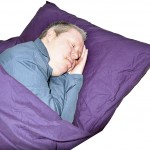
The authors of this study set out to investigate sleep patterns in children with Down syndrome by asking parents to complete a questionnaire on sleep habits. Typical sleep problems included sleep maintenance problems, snoring, and disordered breathing.
The authors administered a 33 item questionnaire on children’s sleep habits to the parents of 35 children with Down syndrome, (mean age, 12.65 years, range 7–18 years).
They found that parents reported that 85% of the sample had sleep disturbance scores in the clinical range and that they reported elevated scores on bedtime resistance, sleep anxiety, night wakings, parasomnias, leep disordered breathing and daytime sleepiness subscales.
The authors conclude that the children in their small sample were at risk for developing symptoms of sleep disordered breathing as well as additional unrelated sleep problems.
Parental report of sleep problems in Down syndrome, Breslin, J. et al., in Journal of Intellectual Disability Research, 55: 1086–1091
